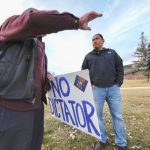
Second breath for Forgotten People: Lawsuit seeking accounting for $60M revived in tribal court
LOS ANGELES
Back in 2010, the Forgotten People filed a lawsuit in an attempt to find out what happened to more than $60 million given to the Navajo Nation for the rehabilitation of lands in the former Navajo-Hopi dispute between the two tribes.
The lawsuit filed in tribal court came more than a decade after the two tribes settled the dispute thus allowing for the first time in almost a half century development of any kind in many communities like Big Mountain.
For hundreds of Navajo families living in the former disputed areas, the settlement of the dispute gave them hope that they would soon see their roads repaired and their communities would receive electricity and running water for homes.
It didn’t take long for them to realize that the promises were being broken and that they had become the tribe’s forgotten people. So they began calling themselves the Forgotten People and tried to get an accounting of where all the money promised to them had gone.
Eleven years after that lawsuit was filed in tribal court, they’re still waiting for that accounting.
Marsha Monestersky, project director for the Forgotten People, sees families being deprived of many of the same benefits that Navajo families living in other parts of the reservation take for granted.
Most homes still don’t have electricity, few roads have gotten any kind of upgrade and families still have to travel as much as 40 miles to get water from the only two wells in the area, she said.
Their plight has once again become public with word during the past week that the 2010 lawsuit, dismissed in 2016, was being reactivated.
It had languished for several years waiting for rulings by former tribal district court judge Carol Perry and was reopened on May 18 by her replacement, Malcolm Begay.
Otto Tso, chairman of the Navajo-Hopi Land Commission, said he applauded the decision by the Navajo Nation Department of Justice for their advocacy in reopening the case, saying he was glad that the voice of the Forgotten People “needs to be heard.”
Mary Lane, president of the Forgotten People, said in a statement that she also welcomed the reopening of the case “as it can provide a way for the directly affected people to have accountability and oversight of funds that are intended to assist in the rebuilding of communities devastated by the Bennett Freeze.”
Because of the ruling by a federal judge, Navajo families were forbidden for 43 years to make renovations to their homes, leading to situations where families were forced to live in one-room hogans as their families grew to include several children.
The tribal government is encouraging the reopening of the lawsuit in hopes that it can be used to get millions of dollars in grants from the federal government to alleviate the suffering of Navajo families in the area.
If this happens, the leaders want to have a seat at the table to make sure that money appropriated to help the Forgotten People actually is used for that purpose and not diverted to other programs.
“If our hardship is responsible for the money coming to the Navajo Nation, then we should have the right to know where it goes,” said Lane.
That was the basic object of the 2010 suit, Rena Babbitt, the main plaintiff in the lawsuit.
So just where did the money go?
As the lawsuit languished in the depths of Perry’s court, there were reports that the records were due to be destroyed because they existed only on paper and these records became encased in mold.
Do these records even exist anymore?
The Forgotten People have never gotten an answer to that question. As a result, whatever help the affected Navajo families have gotten over the years has come from work done by the Forgotten People and that includes the group’s efforts in recent months to help families deal with new hardships created because of the COVID-19 pandemic.
The group’s efforts against the virus included setting up hand-sanitizer stations and providing firewood, five-gallon water barrels and personal protective equipment.
The group also helped Toys for Tots distribute toys this past Christmas to 1,600 children, as well as 600 quilts at a drive-thru set up at the Tonalea and Hardrock chapters.
Some of the missing money, according to the lawsuit, included $15 million given by Congress to the federal Navajo-Hopi Relocation Commission, which is headquartered in Flagstaff, and reportedly received the funds to make conditions in the former disputed area more livable.
Elmer Guy, who represents Dilkon, Indian Wells, Teesto, Whitecone and Greasewood Springs on the Navajo Nation Council, has suggested that the tribe meet with officials of the relocation commission to get some answers about these funds.
Navajo Nation President Jonathan Nez has also gotten involved in recent months, writing to U.S. President Joe Biden about appointments to the relocation commission.








 Highway 264,
Highway 264, I-40, WB @ Winslow
I-40, WB @ Winslow